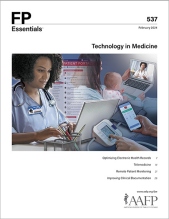
In the 20 years since I started my family medicine residency, I have been involved in the implementation of five different outpatient electronic health record systems. I have used systems that had fairly good functionality but were so poorly implemented that they were nearly unusable. I have used low-cost systems that became very functional and efficient when they were implemented well. In private practice, I have paid the high cost of implementing and changing record systems.
I have seen so much potential for increasing both quality and efficiency that only sometimes translates into better care for patients and better work for physicians. I have been on the receiving end of 200-page faxes for hospital discharges that contain incredible detail but are missing the information needed to provide ongoing care to the patient. I have experienced how electronic health records allow us to address quality in ways that save lives.
In 2018, Stanford Medicine and The Harris Poll conducted research examining how primary care physicians (PCPs) in the United States felt about their electronic health record (EHR) system.1 While more than 60% of PCPs were at least somewhat satisfied with their current EHR and thought that EHRs generally led to improved care, 40% thought that EHRs have more challenges than benefits. Only 18% of PCPs were very satisfied with their current EHR system. Although 70% of PCPs thought that EHRs had improved over the previous 5 years, most thought that EHRs need a complete overhaul. About 70% of physicians thought that using an EHR increases total work hours, contributes greatly to physician burnout, and takes valuable time from patients.
Section One of this monograph discusses optimizing EHRs and reviews some of the negative and positive effects of EHR adoption. Telehealth and telemedicine are discussed in Section Two. Section Three explores remote patient monitoring. Section Four examines ways to improve clinical documentation including use of EHR best practices and clinical documentation aids.
I am sure that you, like me, have experienced frustrations in using your EHR. I hope that the information in this edition will empower you to optimize your EHR and related technology to increase efficiency, reduce burnout, and improve outcomes for your patients.
Ryan D. Kauffman, MD, FAAFP, CCFP,
Associate Medical Editor, Family Medicine Physician
Erie Shores Family Health Team, Leamington, Ontario, Canada
